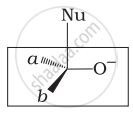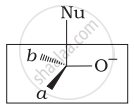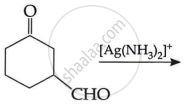Advertisements
Advertisements
प्रश्न
What is meant by the following term? Give an example of the reaction in the following case.
Oxime
उत्तर
Oximes are formed by reaction between aldehydes or ketones and hydroxylamine. The reaction is carried out in a mildly acidic condition.
\[\begin{array}{cc}
\ce{H3C}\phantom{...........................}\ce{H3C}\phantom{.....................}\\
\backslash\phantom{..............................}\backslash\phantom{................}\\
\ce{= O + \underset{Hydroxylarnine}{H2N-OH} ->[pH 3.5] \phantom{......}= NOH + H2O}\\
/\phantom{..............................}/\phantom{.................}\\
\ce{H}\phantom{............................}\ce{\underset{Oxime}{H}}\phantom{..................}
\end{array}\]
APPEARS IN
संबंधित प्रश्न
Write balanced chemical equations for action of ammonia on - formaldehyde
Draw the structure of the semicarbazone of ethanal.
What is meant by the following term? Give an example of the reaction in the following case.
Acetal
What is meant by the following term? Give an example of the reaction in the following case.
Schiff’s base
Acetaldehyde, Acetone, Di-tert-butyl ketone, Methyl tert-butyl ketone (reactivity towards HCN)
Complete the synthesis by giving missing starting material, reagent or product.
\[\ce{C6H5CHO ->[H2NCONHNH2]}\]
Explain the mechanism of alkaline hydrolysis of tert-butyl bromide with energy profile diagram.
Write the structure of Phenylmethanamine.
What are amines?
Which of the following is the correct representation for intermediate of nucleophilic addition reaction to the given carbonyl compound (A):

(i) 
(ii) 
(iii) 
(iv) 
The most stable reagent for the conversion of R – CH2OH → RCHO is
What is the action of sodium hypoiodite on acetone?
What happens when ethanal is treated with excess ethanol and acid?
Which will undergo faster nucleophilic addition reaction?
Acetaldehyde or Propanone
The following questions are case-based questions. Read the passage carefully and answer the questions that follow:
| The carbon-oxygen double bond is polarised in aldehydes and ketones due to higher electronegativity of oxygen relative to carbon. Therefore, they undergo nucleophilic addition reactions with a number of nucleophiles such as HCN, NaHSO3, alcohols, ammonia derivatives and Grignard reagents. Aldehydes are easily oxidised by mild oxidising agents as compared to ketones. The carbonyl group of carboxylic acid does not give reactions of aldehydes and ketones. Carboxylic acids are considerably more acidic than alcohols and most of simple phenols. |
Answer the following:
(a) Write the name of the product when an aldehyde reacts with excess alcohol in the presence of dry HCl. (1)
(b) Why carboxylic acid is a stronger acid than phenol? (1)
(c) (i) Arrange the following compounds in increasing order of their reactivity towards CH3MgBr: (1)
CH3CHO, \[\begin{array}{cc}
\ce{(CH3)3C-C-CH3}\\
\phantom{....}||\\
\phantom{....}\ce{O}
\end{array}\], \[\begin{array}{cc}
\ce{CH3-C-CH3}\\
||\\
\ce{O}
\end{array}\]
(ii) Write a chemical test to distinguish between propanal and propanone. (1)
OR
(c) Write the main product in the following: (2)
| (i) |  |
| (ii) |  |
Draw the structure of the following derivative.
Acetaldehydedimethylacetal
Draw the structure of the following derivative.
The ethylene ketal of hexan-3-one
Draw structure of the following derivative:
Acetaldehydedimethylacetal
Draw structure of the following derivative:
Acetaldehydedimethylacetal
Draw the structure of the given derivative.
The ethylene ketal of hexan-3-one
